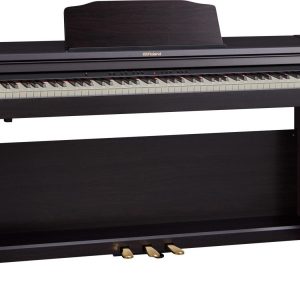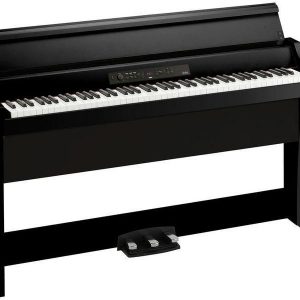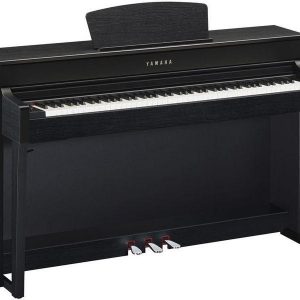Yamaha DGX-660
$582.99
Experience the brilliance of Yamaha DGX-660 digital piano, the perfect instrument for both beginners and professionals, featuring authentic sound, weighted keys, and endless creative possibilities.
Compare
Description
The Yamaha DGX-660 digital piano is a true masterpiece that offers a wide range of features and capabilities. Designed with beginner and intermediate players in mind, this piano provides an unparalleled playing experience that is both fun and engaging.
One of the most notable features of the DGX-660 is its impressive sound quality. With its Pure CF sound engine, this piano comes packed with a wide selection of sounds that are modeled after the famous CFIIIS concert grand piano. This sound engine also boasts an impressive 192-note polyphony, ensuring that every note played is clear and crisp.
In addition to its world-class sound, the Yamaha DGX-660 also offers a wide range of features that make it an ideal piano for practice and performance. The keyboard comes equipped with a variety of learning tools, including a built-in lesson function that allows players to practice at their own pace. Additionally, the piano features a variety of effects and settings that can be used to enhance the sound, including chorus, reverb, and EQ.
Beyond its internal features, the Yamaha DGX-660 also boasts a sleek and stylish design that is sure to impress. The piano features a full 88-key keyboard, complete with weighted keys that simulate the feel of an acoustic piano. It also comes equipped with a built-in amp and speakers, making it a truly all-in-one piano that can be played anywhere, at any time.
Overall, the Yamaha DGX-660 is an incredible piano that offers a wide range of features and capabilities. Whether you’re a beginner looking to learn the piano or an experienced player looking for a high-quality digital alternative to an acoustic piano, the DGX-660 is a fantastic option that is sure to impress.
Yamaha DGX-660 properties
| Product name |
DGX-660 |
| Brand |
Yamaha |
| Type |
Keyboard Instruments |
| Keyboard Instrument |
Stage and Digital Piano |
| Keys |
Yes |
| Number of Keys |
88 pcs |
| Key Functions |
Dual Layer, Split, Weighted Keys |
| Pre-Programmed Songs |
Yes |
| Pre-Programmed Effects |
Yes |
| Portable |
Yes |
| Supported Audio Files |
SMF, WAV |
| Connections |
3.5mm (Aux), Headphone, Microphone, USB |
| Colour |
Black, White |
Frequently Asked Questions:
How does the Yamaha Smart Pianist app integrate with the DGX-660 digital piano to provide personalized instruction and performance feedback?
The Yamaha Smart Pianist app is designed to integrate seamlessly with the Yamaha DGX-660 digital piano, providing personalized instruction and performance feedback. The app can be downloaded for free from the App Store or Google Play, and once connected via Bluetooth or USB to the piano, it allows users to select songs from the app's vast library or access songs saved on a smart device, USB flash drive, or other sources. The app offers a variety of features that enhance the user's experience, including:
- Audio To Score, which converts recorded performances into sheet music, allowing users to study their playing and improve their skills
- Digital sheet music displays, with interactive elements like chord symbols, metronome, and adjustable tempo controls
- Accompaniment Styles, which provide automatic bass, chords, and melodies that follow the user's playing in real time
- Recording and playback functions, allowing users to save their performances or listen back for analysis
- A lesson mode with interactive quizzes and games that teach music theory concepts like scales, arpeggios, and sight-reading skills. Overall, the Yamaha Smart Pianist app integrates seamlessly with the DGX-660 digital piano, providing users with a comprehensive learning and performance toolkit that enhances their musical abilities.
What unique features does the Yamaha DGX-660 digital piano offer, particularly in regards to its Stagea and Digital Signal Processing technologies?
The Yamaha DGX-660 digital piano stands out with its advanced Stagea and Digital Signal Processing (DSP) technologies. Stagea is a unique feature that enhances the overall sound experience by creating a more immersive environment for performers and audiences alike. This technology utilizes advanced spatial and reverb effects to simulate the acoustics of a concert grand piano, as well as other instruments and spaces, such as a cathedral or opera house. As a result, the DGX-660's sound is incredibly rich, detailed, and lifelike, making it perfect for both practice sessions and live performances. In addition to Stagea, the DGX-660 also incorporates Yamaha's acclaimed Digital Signal Processing (DSP) technology. This feature allows for a wide variety of sounds and effects to be added to the piano's core sound, including everything from strings and brass to synthesizers and vocal samples. The DSP engine is powerful enough to allow for real-time processing of multiple sounds simultaneously, resulting in incredibly complex and rich textures and harmonies. The combination of Stagea and DSP technology makes the Yamaha DGX-660 an exceptional choice for musicians of all levels, whether they are just starting out or are experienced performers looking to take their sound to the next level. With its stunning sound quality, wide range of features, and intuitive user interface, this digital piano is a top-of-the-line instrument that is sure to inspire and delight players for years to come.
How does the enhanced Smart Pianist app integration on the Yamaha DGX-660 differ from previous models, and what specific features does it offer to music learners and performers?
The enhanced Smart Pianist app integration on the Yamaha DGX-660 sets it apart from previous models in several ways. Firstly, the app offers a wider range of functions that can be controlled via Bluetooth MIDI, making it more versatile and convenient for music learners and performers. One of the most significant features is the Chord Tracker function, which enables users to follow along with songs in their Smart Pianist library using digital sheet music. The app analyzes the chords and key signatures of the song and displays them on the screen, allowing users to play along at their own pace. This feature is particularly helpful for beginners who are learning to play by ear or for those who want to practice their chord progressions. Another useful feature is the Lesson function, which provides interactive tutorials that teach users how to play popular songs step by step. The app offers a range of difficulty levels and displays visual feedback on the screen to help users improve their skills. This feature is ideal for music learners who want to build confidence and learn new techniques in a structured way. The Smart Pianist app also includes a Recording function, which allows users to capture their performances and listen back to them later. Users can save multiple recordings and compare them side by side to see their progress over time. This feature is great for performers who want to refine their skills and work on specific aspects of their playing. Overall, the enhanced Smart Pianist app integration on the Yamaha DGX-660 offers a range of features that are tailored to the needs of music learners and performers. Whether you're learning to play for the first time or looking to improve your skills, this digital piano provides a comprehensive learning experience that is both fun and engaging.
What unique features does the Yamaha DGX-660 digital piano possess that make it stand out from other stage pianos in terms of sound quality, functionality, and design?
The Yamaha DGX-660 digital piano boasts several unique features that set it apart from other stage pianos in terms of sound quality, functionality, and design. Here are some notable ones:
1. Sound Quality: The DGX-660 is equipped with Yamaha's premium Pure CF Sound Engine, which uses samples of the renowned Yamaha CFIIIS concert grand piano. This technology delivers a rich, authentic sound that is unmatched in digital pianos. Functionality: The DGX-660 offers a wide range of features that are essential for stage performances. Its USB Audio Recorder allows users to capture their performances in high-quality audio format, while the built-in Bluetooth connectivity enables wireless communication with other compatible devices. Design: The sleek and modern design of the DGX-660 is a standout feature. Its slim cabinet and wooden keys provide an elegant look, making it a stylish addition to any stage setup. Easy-to-Use Interface: Yamaha's Smart Pianist app provides an intuitive interface that makes it easy to control the DGX-660. Users can adjust settings, select sounds, and even display lyrics or chord charts on their smart devices via Bluetooth connectivity. Overall, the Yamaha DGX-660 digital piano is a top-of-the-line stage piano that combines exceptional sound quality, advanced functionality, and sleek design to provide musicians with an unparalleled playing experience.
What is the difference in piano sound quality between the built-in digital pianos, such as the Bösendorfer Imperial and the Grand Piano, on the Yamaha DGX-660?
The built-in digital pianos on a keyboard like the Yamaha DGX-660 are often referred to as "stage pianos" or "performance pianos. These instruments have a more simplified sound generation compared to high-end digital pianos like the Bösendorfer Imperial. In terms of sound quality, the main differences lie in the sampling technology and the overall tone shaping. The DGX-660 uses Yamaha's AWM (Advanced Wave Memory) technology for its sound samples. This is a type of sample-based sound generation that stores small segments of recorded audio data. These segments are then looped together to create a seamless sound. In contrast, high-end digital pianos like the Bösendorfer Imperial use more advanced sampling technologies such as Yamaha's CFX or Steinway's own sound technology. These instruments store longer samples and can offer a much wider range of tonal nuances. Another key difference is the tone shaping. The DGX-660 has a more limited set of tone-shaping parameters, which are primarily focused on adjusting the overall brightness and character of the sound. In contrast, high-end digital pianos like the Bösendorfer Imperial offer a much wider range of tonal options, including subtle adjustments to the attack, decay, sustain, and release (ADSR) envelope. Lastly, it's worth noting that even with more advanced sampling technology, the overall tone quality is still dependent on the speaker system and amplifier used in the instrument. High-end digital pianos like the Bösendorfer Imperial often have higher-quality speakers and amplifiers that can bring out more detail and nuance in the sound. Overall, while the built-in piano sounds on the DGX-660 are serviceable for casual playing or practice, they lack the depth and complexity of high-end digital pianos. If you're looking for a more authentic piano experience, it's worth investing in a dedicated digital piano or even an acoustic instrument.
What is the difference between the Yamaha DGX-660's "Multi-Pad" and "Sound Control" functions, and how do they affect the overall sound production of the instrument?
The Yamaha DGX-660 is a versatile digital piano that features a range of advanced sound control and performance tools. Two key functions on this keyboard are the Multi-Pad and Sound Control. The Multi-Pad function allows you to manipulate sounds in real-time using a touch-sensitive pad located above the keys. This feature enables various effects such as reverb, chorus, and other types of processing for individual sounds or entire sound groups. It essentially gives users access to advanced editing capabilities similar to professional digital audio workstations but within the context of live performance. In contrast, Sound Control provides more in-depth adjustments to how sounds are produced on the instrument. This includes options for altering parameters like filter cutoff frequency and resonance, allowing for a wide range of tonal variations from subtle to dramatic changes. It also offers more granular control over sound envelopes, making it ideal for users who want precise customization of their performances. When considering the impact these functions have on overall sound production, the Multi-Pad primarily focuses on adding ambiance or modifying existing sounds in real-time during a performance. This can be particularly useful for jazz or electronic musicians looking to add dynamic textures to their music without needing extensive technical knowledge. The Sound Control function, on the other hand, delves deeper into sound design and manipulation at a more fundamental level. It allows users to alter the basic characteristics of sounds, effectively creating new timbres or modifying existing ones in ways that would be difficult or impossible with traditional keyboard controls. This feature can be particularly useful for producers and composers looking to create unique or complex sounds within their music. Ultimately, both functions are powerful tools that expand the creative possibilities of the Yamaha DGX-660. While they serve different purposes, they complement each other by providing a range of options for manipulating sound in real-time during performance, as well as more in-depth editing capabilities for fine-tuning and customizing sounds to suit specific musical needs.
Before you buy Yamaha DGX-660






Arnold Fox –
The piano is worth recommending, it looks very elegant visually, but most importantly, the quality of workmanship and the sound of the piano itself, considering that it is a digital piano, exceeded my expectations.
In addition, the price – relatively low compared to the costs of buying a real piano, summing up if you start your journey with playing the piano, with KDP 110 you can say that you start with high C